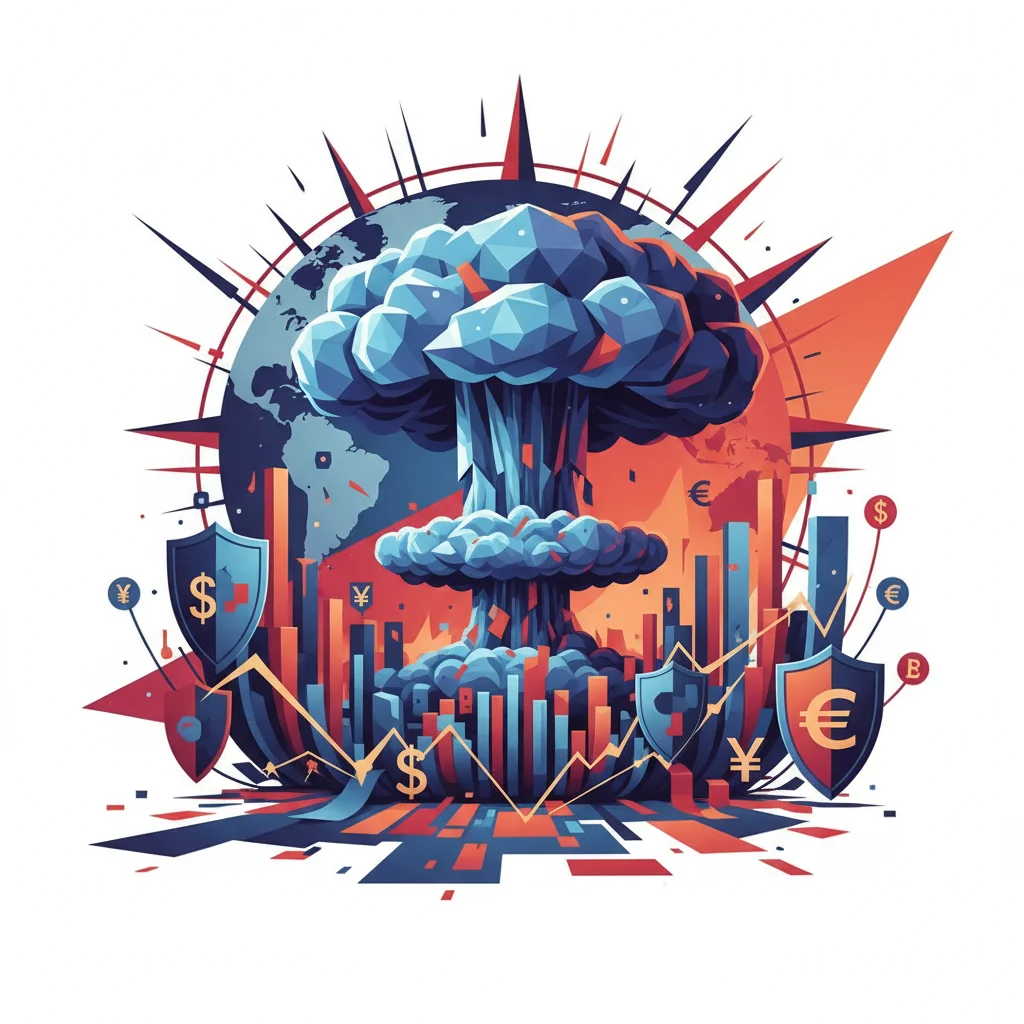
The New Nuclear Shadow: How Geopolitical Tensions Are Redefining Global Finance and Investment Strategy
The New Nuclear Shadow: How GeopolITICAL Tensions Are Redefining Global Finance and Investment Strategy
In a move that echoes the darkest days of the Cold War, Russian President Vladimir Putin has signaled a potential return to nuclear weapons testing, a development that sends a chilling message across the international community. According to a report from the Financial Times, Putin has instructed officials to prepare for such tests, framing the action as a direct response to perceived threats and potential moves by the United States. This declaration is more than just military posturing; it is a significant geopolitical event with profound and far-reaching implications for the global economy, international investing, and the very fabric of our interconnected financial systems.
For decades, the world has operated under the fragile assumption that nuclear escalation was a relic of the 20th century. A global framework of treaties and mutual understanding, however strained, kept the most destructive weapons in their silos. Putin’s recent statements threaten to shatter this long-standing equilibrium, potentially heralding a new, and dangerously unpredictable, atomic arms race. For business leaders, investors, and finance professionals, ignoring this development as a distant political affair would be a grave miscalculation. The shockwaves from such a seismic shift in global security will inevitably reach the stock market, the banking sector, and every corner of the financial world.
A Fraught History: The Erosion of Arms Control
To understand the gravity of the current moment, we must look back at the architecture of arms control painstakingly built over half a century. Treaties like the Comprehensive Nuclear-Test-Ban Treaty (CTBT), adopted by the UN General Assembly in 1996, were designed to be the bedrock of non-proliferation. While the CTBT has yet to formally enter into force—as it requires ratification by key states, including the United States—it established a de facto global moratorium on nuclear testing. Russia ratified the treaty in 2000, but in late 2023, Putin signed a law revoking this ratification, a move that many saw as a clear signal of intent.
This follows the steady decay of other critical agreements. The Intermediate-Range Nuclear Forces (INF) Treaty collapsed in 2019, and Russia suspended its participation in the New START treaty—the last remaining major arms control pact with the U.S.—in early 2023. Each dismantled pillar of this security architecture increases global risk.
Below is a summary of the current status of key arms control agreements, highlighting the trend of erosion:
| Treaty / Agreement | Purpose | Current Status |
|---|---|---|
| New START Treaty | Limits deployed strategic nuclear warheads and bombs for the U.S. and Russia. | Russia suspended its participation in February 2023. Set to expire in 2026. |
| Intermediate-Range Nuclear Forces (INF) Treaty | Eliminated an entire class of nuclear missiles (ranges 500-5,500 km). | Terminated in August 2019 after both U.S. and Russia withdrew. |
| Comprehensive Nuclear-Test-Ban Treaty (CTBT) | Bans all nuclear explosions for both civilian and military purposes. | Not in force. Russia de-ratified in November 2023, though it remains a signatory. |
This systematic unraveling creates a vacuum of trust and verification, pushing the world closer to a state of heightened alert and strategic miscalculation. The return of nuclear testing by a major power would not just be a symbolic act; it would be a practical step toward developing new, potentially more destabilizing, weapon systems.
The Soul Gap: Why EV Performance Isn't Enough for Long-Term Investment Success
The Economic Ripple Effect: From Market Volatility to Sector-Specific Tremors
While the immediate focus is on national security, the second- and third-order effects on the global economy are undeniable. Investors and financial institutions must begin pricing in a new, more aggressive layer of geopolitical risk.
1. Heightened Market Volatility and Capital Flight
Geopolitical instability is a primary driver of market volatility. The mere suggestion of a renewed nuclear arms race introduces a level of uncertainty not seen in decades. In such an environment, we can expect to see classic “risk-off” behavior in the stock market. Investors will likely shift capital away from equities, particularly in emerging markets or regions perceived as vulnerable, and towards traditional safe-haven assets. Gold, the U.S. Dollar, and Swiss Franc typically benefit from this flight to safety. For those involved in active trading, this means preparing for sharper, more unpredictable market swings driven by headlines rather than fundamentals.
2. The Macroeconomic Burden of an Arms Race
A new arms race would be incredibly expensive. Nations would be forced to divert trillions of dollars from productive sectors of the economy—such as infrastructure, healthcare, and education—towards military modernization and weapons development. This has significant macroeconomic consequences. Increased government spending on defense, if not offset by tax hikes or cuts elsewhere, leads to larger budget deficits and rising national debt. This, in turn, can put upward pressure on interest rates and crowd out private investment, ultimately slowing long-term economic growth. The principles of economics dictate that such a massive reallocation of resources is inherently inefficient and carries a steep opportunity cost for society.
3. Sector-Specific Impacts: Winners and Losers
Not all sectors will be affected equally. A renewed focus on military capabilities would almost certainly benefit the defense, aerospace, and cybersecurity industries. Companies like Lockheed Martin, Northrop Grumman, and BAE Systems could see a significant increase in government contracts, making their stocks attractive to certain investors. Conversely, industries reliant on global supply chains and international cooperation—such as manufacturing, technology, and tourism—could suffer from heightened tensions, trade disruptions, and a decline in cross-border investment.
The Apple Tax on Trial: How a UK Ruling Could Redefine Big Tech's Financial Power
The Role of Finance and Technology in a Fractured World
The modern financial system is both a potential battleground and a critical tool in this new era of competition. The banking sector is on the front lines, tasked with enforcing an increasingly complex web of international sanctions. This has accelerated the demand for sophisticated compliance systems, driving innovation in regulatory technology (RegTech), a key subset of financial technology.
Furthermore, the weaponization of finance—such as cutting off access to the SWIFT messaging system—is pushing nations like Russia and China to accelerate the development of alternative financial infrastructures. This is where emerging technologies like blockchain and central bank digital currencies (CBDCs) enter the geopolitical arena. There’s a growing incentive for sanctioned states to create parallel payment systems that can operate outside the traditional, Western-dominated financial architecture. As noted by the Carnegie Endowment for International Peace, this could lead to a gradual fragmentation of the global financial system, creating new risks and reducing the effectiveness of future economic sanctions.
This technological arms race in fintech runs parallel to the military one. The ability to control capital flows, secure financial networks against cyberattacks, and maintain economic stability amidst geopolitical shocks is now a core component of national power. For the financial industry, this means navigating a landscape where political risk, technological disruption, and security threats are more intertwined than ever before.
A Tale of Two Titans: Why Wall Street Cheered Google's AI Strategy and Jeered Meta's
Conclusion: Navigating the Uncharted Waters Ahead
President Putin’s threat to resume nuclear testing is a stark reminder that the specter of nuclear conflict has not been banished to the history books. It is a present and growing risk that must be integrated into our strategic thinking. For the financial community, this is not an abstract threat but a tangible factor that will influence market behavior, capital allocation, and long-term economic forecasts.
The potential for a new arms race demands a recalibration of risk models and investment strategies. It underscores the need for portfolio diversification, an understanding of safe-haven assets, and a keen awareness of the sectors most vulnerable to geopolitical turmoil. Beyond the immediate trading implications, it signals a fundamental shift in the global order—one that will challenge the foundations of the globalized economy we have known for the past three decades.
As we move forward, vigilance, adaptability, and a deep understanding of the intersection between geopolitics, economics, and finance will be the most valuable assets for any investor, business leader, or policymaker seeking to navigate these turbulent and uncharted waters.


